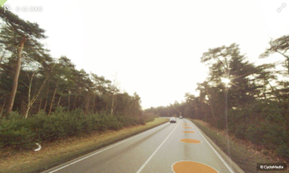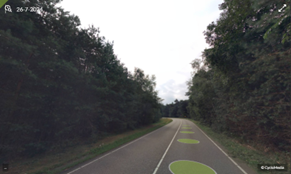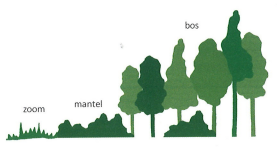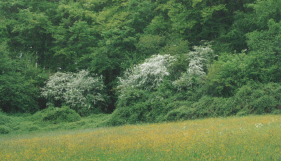Forest edge will be addressed next year for biodiversity, climate resilience, traffic safety and fire safety
Watch the video about the work on the forest edge and power grid here:
The forest edge of Gentian Avenue will be redesigned in early 2025 and thus greatly improved. There will be a smooth transition from a flowery verge, via bushes, to the forest behind. From low to high. This will improve biodiversity, climate resistance, traffic safety and fire safety.


If we do nothing, the current situation (Figure 2) will gradually change into an open forest edge with bare trunks, similar to what can be seen in Figure 1.
Also, work to future-proof the power grid
At the same spot, up to the Australia Avenue traffic circle, additional electricity cables are being laid to strengthen the energy network. The current supply does not meet the electricity consumption in the (near) future. By widening the forest edge, Enexis employees can carry out their work safely and there will be minimal inconvenience on the road for road users. Preparations by Enexis will start in December of this year. In January we will inform residents in more detail about the continuation of the work by Enexis and about the work on the forest edge.
What will happen?
The work for the power cables will be carried out entirely from the roadside. For this we remove a wider strip (at least 9 meters) of vegetation (young trees). Because the distance from the edge of the forest to the road varies, more is removed in some places than in others. After the work, an open and bare view is temporarily created. The forest edge will be replanted in a sloping manner and will need 1 to 5 years to develop into a varied forest edge. After the completion of the cable work we will rearrange the edge of the forest. Through a gradual transition from a flowery verge, via shrubs, to the forest behind. From low to high, as shown in the illustration. At the outer edge of the verge a flowery herb mixture will be sown. This will provide an attractive appearance already in the first growing season.


The modifications to the forest edge have many advantages!
- A flowery herb mixture in the front berm edge, already provides an attractive appearance in the first growing season and offers a valuable food source for insects;
- Different shrub species along the forest edge create a closed edge with more variety. This creates a more varied habitat that benefits more species of plants, animals and insects;
- The closed forest edge forms a protective layer around the forest and enhances the unique forest climate. This makes the forest more resilient to extreme weather conditions. In summer it stays cooler and more humid, and wind dries out the forest less quickly. This climate provides additional protection for plants and animals, especially during heat and drought. The forest climate is distinctly different from that of the open area around it;
- A wadi in the verge near the intersection with Bestseweg, captures excess rainwater during peak showers and prevents flooding on the road. In addition, this will create a wetter environment locally, increasing biodiversity in the area;
- Deer roam at this spot, which the forest edge to the road brings them too close to traffic. This increases the risk of collisions. By setting the forest edge back slightly, we reduce the risk of dangerous situations;
- The spontaneous growth of pines obstructs visibility in some places and reduces road safety. To improve this, until now we pruned the conifers. This eventually causes bare trunks, which is already visible in some places. These open spots make the forest more vulnerable. Precisely by laying back the forest edge slightly and closing it again, we improve visibility, increase traffic safety and protect the forest climate.
- We incorporate the released wood into branch rills along the forest edge. This provides shelter for animals and insects and helps enrich the soil with nutrients;
- Conifers burn faster than shrubs with leaves. In dry summers, fires, such as from a discarded cigarette butt, can quickly spread to the forest. Replacing Scots pines with a mantle of shrubs reduces the risk of wildfires;
What should residents consider?
- The current conifers will be removed, temporarily creating a bare appearance in the forest. More road noise may also be temporarily audible in the Son forest.
- Enexis work will cause limited traffic disruption. Half of the roadway will be closed for 1 week.
What is the schedule?
An explosives survey for possible war remnants at that site will take place in late December. Prior to that, a number of trees in the forest edge must be removed. In February 2025, Hurkmans will start work on the power line. Redevelopment of the forest edge will begin as soon as this work is completed. Starting in the 2025 growing season, the first flowers and herbs will be visible at the edge. The shrubs in the forest edge beyond will need 1 to 5 years to become large and sturdy.